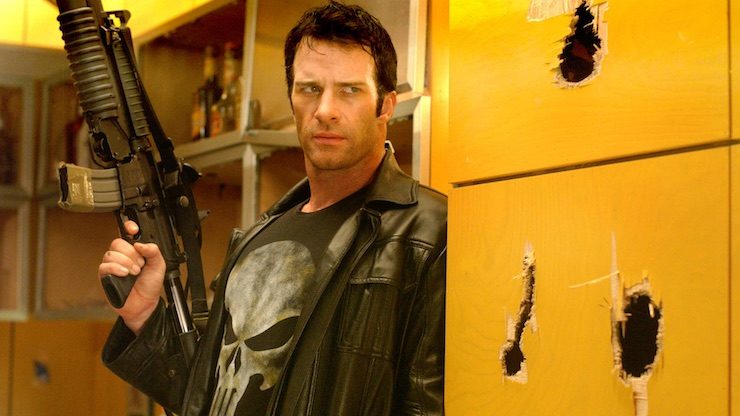The Punisher first appeared in the comics in 1974 in an issue of The Amazing Spider-Man. He showed up as a guest star in many comics over the next twelve years before getting a miniseries by Steven Grant and Mike Zeck in 1986 which was a huge hit. That led to a slew of Punisher comic books, particularly in the late 1980s and 1990s when the more violent heroes (see also Wolverine and Ghost Rider and Lobo) were becoming more popular.
That popularity also led to a movie with Dolph Lundgren in 1989 that was not much of a hit and barely got released. When superhero movies took off in the early 2000s, another shot was taken with Thomas Jane in 2004, and then another with Ray Stevenson in 2008.
The Punisher was originally a Vietnam veteran named Frank Castle. He came home from the war only to see his family murdered by mobsters. (In Marvel, they were called the Maggia, their version of the Mafia.) This sent him over the edge, and now Castle goes out as the Punisher, using his combat skills to kill bad guys, making him something of an antihero. His initial appearance has him going after Spider-Man, who has been accused of murdering Norman Osborn.
The character’s backstory was very obviously inspired by Don Pendleton’s Mack Bolan, a.k.a. the Executioner. However, while Bolan went on after wiping out the Mafia to become a government agent in adventures that are still published to this day (your humble rewatcher has actually written two of them…), the Punisher became a vigilante, whose level of sanity has varied depending on who’s writing him.
The first movie was produced by New World, who were the owners of Marvel Comics at the time. However, New World’s financial issues led to a rather scattershot release—it debuted in Europe in 1989, not actually showing up in U.S. theatres until 1991, and that only in very limited release. Starring Dolph Lundgren, who had made a name for himself as Rocky’s Russian opponent in Rocky IV, the movie changed his backstory to that of an ex-cop, and had the main bad guys be Yakuza rather that Mafia. (They filmed in Sydney, and it was probably easier to get Japanese actors anyhow…)
Marvel had a deal with Artisan Studios to produce films based on some of their characters, and the first (and last, as Artisan was bought by Lionsgate and shuttered) was a new take on the Punisher. The character was moved to Florida because it was cheap to film there. The movie did decently enough at the box office (despite awful reviews) to warrant a sequel, but creative issues led to the “sequel” being the completely unrelated Punisher: War Zone with Ray Stevenson replacing Thomas Jane in the title role. Both the 21st-century takes used the comics as more direct inspiration than the 1989 film, with Jane’s movie based on Punisher: Year One and The Punisher: Welcome Back, Frank, while Stevenson’s used several elements from the comics, notably the characters of Jigsaw and Microchip.
None of the movies were critical successes, and all three were plagued by production and release difficulties. The character would next be seen on screen as part of Marvel’s Netflix slate, first in the second season of Daredevil (a meeting partly inspired by the Punisher’s appearance during Frank Miller’s first run on DD in the 1980s) and then in his own series, which will debut next week.
“What the fuck do you call 125 murders in five years?” “Work in progress.”
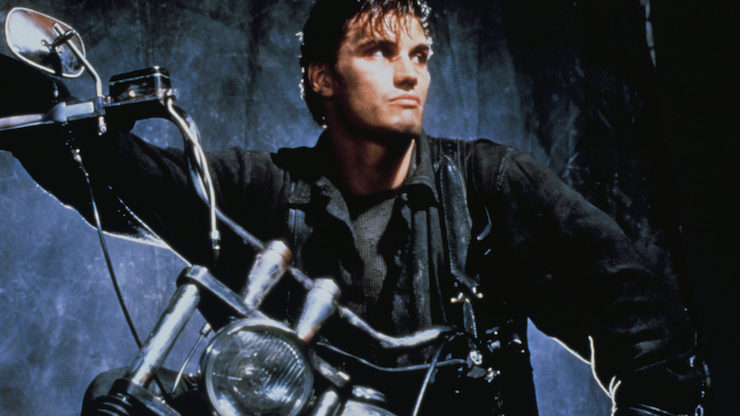
The Punisher
Written by Boaz Yakin
Directed by Mark Goldblatt
Produced by Robert Mark Kamen
Original release date: October 5, 1989
After five years, Dino Morretti has been acquitted of the murder of Detective Frank Castle and his wife and children. There’s also a vigilante known as “the Punisher,” who has been killing mobsters for the past five years. Lieutenant Jeff Berkowitz—Castle’s former partner—believes that Castle isn’t dead and that he’s the Punisher. But there’s no evidence as to who the Punisher is, even though he leaves knives and shell casings at every scene and forensic science did actually exist in the 1980s. Those knives and shell casings are in a box on Berkowtiz’s desk—why they’re there instead of bagged in evidence is left as an exercise for the viewer.
Berkowtiz is, in fact, correct, as Castle has been living in the sewers, waging a one-person war on criminals. He’s killed more than a hundred mobsters in five years, and he adds to that count by killing Morretti and his thugs and also blowing up his house.
At this point, Berkowitz is something of a joke in the department, since nobody else believes that Castle is alive. But Castle helped get Berkowitz out of alcoholism and Berkowitz owes him. Berkowitz explains this to Detective Sam Leary, who pretty much bullies her way into being Berkowitz’s new partner by saying that she also believes that Castle is the Punisher. She also figures out that Castle’s hideout maybe is underneath the city, the one place in five years Berkowitz hasn’t looked.
There are two responses to this razing of the local criminal elements. The first is Gianni Franco coming out of retirement to unite what’s left of the Mafia families. His first act after doing so is to bring in a huge batch of heroin, but Castle screws that up by massacring the mobsters and sellers and leaving the dope for the cops.
The second is Lady Tanaka of the Yakuza deciding to move in and take over. Franco refuses her offer, and they go to war. The first salvo of the war is Tanaka kidnapping the children of Franco and all his lieutenants and holding them for ransom.
Castle finds out about the Yakuza moving in from his snitch, a drunken ex-actor named Shake, who always speaks in rhyme for no compellingly good reason. He trashes one of their casinos by way of making it clear that they’re not welcome.
Tanaka has no intention of ransoming the kids back to the mobsters, preferring to sell them into slavery. She also kills the mobsters who show up to pay the ransom. Franco, however, has refused to play ball, so he avoids the death spree for now.
Castle attacks one of the Yakuza hideouts, but gets his ass handed to him. Tanaka tortures him and Shake both, but he manages to escape and find out where the kids are being held. Castle enacts a rescue, involving lots of gunplay and a stolen city bus, and gets all but one of the kids away—the exception is Franco’s son Tommy. However, his purloined bus is stopped by a police blockade, and Castle is forced to surrender.
Berkowitz confronts Castle in his cell, wanting to know why he faked his death, why he didn’t come to Berkowitz, why he went crazy and killed over a hundred people. Castle is less than forthcoming, and Berkowitz leaves in disgust and resigns from the force. (Hilariously right when his star should be back on the rise, since his crazy theory was proven correct.)
The transport truck bringing Castle to prison is ambushed by Franco’s people. Franco wants Castle’s help in getting Tommy back, and he’s taken Berkowitz prisoner as leverage. Castle agrees.
Castle and Franco storm the Yakuza headquarters. Berkowitz frees himself from Franco’s dumb-as-posts thugs and calls in the cops, but by the time they arrive, Castle and Franco have killed, basically, everyone. Tanaka holds a knife to Tommy’s throat and tells Franco to eat his gun, which he’s about to do to save his son, but then a badly beat-up and wounded Castle bursts in and throws a knife at Tanaka’s head. Franco repays Castle by threatening to kill him, but Castle manages to stop him—with unexpected help from Tommy, who doesn’t want to see his father kill someone. However after Castle kills Franco, Tommy threatens to kill Castle, but the kid can’t pull the trigger. Castle tells Tommy that he’d better not become like his father and disappears just before Berkowitz enters.
“Good memories can save your life.”
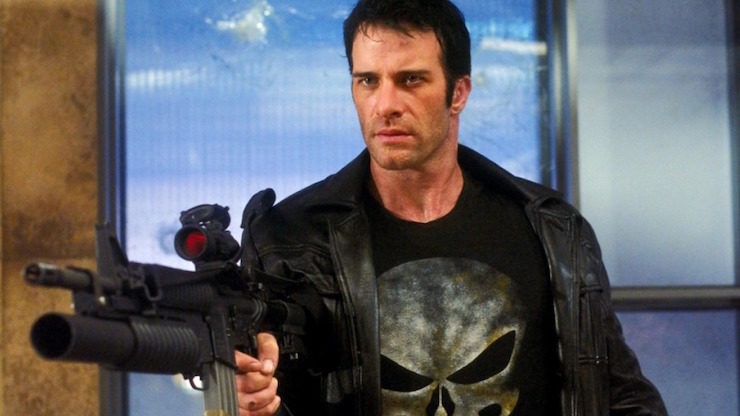
The Punisher
Written by Jonathan Hensleigh and Michael France
Directed by Jonathan Hensleigh
Produced by Avi Arad and Gale Anne Hurd
Original release date: April 16, 2004
In Tampa, Mickey Duka is buying arms from a German arms dealer named Otto Krieg. Along for the ride is Bobby Saint, the son of Howard Saint, a mob boss. Bobby is fronting some of the money for the sale. The FBI shows up and shoots Krieg dead. Then Bobby rather stupidly raises his gun while surrounded by dozens of armed federal agents, and gets himself shot to pieces.
Krieg and Bobby’s bodies are taken away, and we find out that “Krieg” is really Agent Frank Castle, ex-Delta Force, on his last undercover operation before transferring to a cushy desk assignment in the London office. Castle is looking forward to spending time with his family. To that end, he goes with his wife and kid to Puerto Rico for a family reunion.
Saint is livid at the death of his son, and he expends tremendous resources to learn that Krieg was really a federal agent, and also still alive. He sends Bobby’s twin brother John along with his chief enforcer Quentin Glass to Puerto Rico, where they massacre Castle’s entire family, culminating in running over his wife and son. They shoot Castle twice and blow up the pier they shot him on, but Castle survived, went limp, and the explosion blew him out to sea, where he was rescued by a local fisher.
He heals up over five months and returns to Tampa. Amazingly, despite being shot twice, he shows no scarring on his torso when he goes shirtless. (Which he does, y’know, a lot.) He is displeased that the FBI has made no arrests in the murder of his entire extended family.
Castle moves into a shitty apartment that he fills almost entirely with weaponry. The other three apartments in the building are rented by Joan—a diner server who has had a series of abusive relationships—Dave, and Bumpo. The other three are fascinated by Castle’s routine, which involves stockpiling weapons and armoring his car.
Duka is bailed out by Saint, and then gives Saint the name of the buyer, which is what led Saint to Castle. However, five months later, Duka is out working for Saint, still, with no mention of his arrest on federal charges for gun smuggling. Anyhow, Castle kidnaps Duka and fake-tortures him. Duka has little love for the Saint family, so he caves pretty quickly and becomes Castle’s inside man. Duka also reveals that Saint only wanted Castle dead—it was his wife, Livia, who wanted Castle’s entire family to die.
One of Joan’s exes shows up, and Castle scares him off. In return, Joan invites him to join her, Bump, and Dave for dinner, which Castle is reluctant to accept.
Using Duka’s information, Castle tails Saint, Livia, and Saint’s lieutenants, learning that Glass is a closeted homosexual. He sets events in motion to make Saint think that Glass and Livia are having an affair.
Castle also trashes one of Saint’s money laundering operations (stealing some money for himself and donating more money to people on the nearby street) and then one of the transfers to a pair of Cubans for whom Saint launders money. The Cubans are not happy and Saint isn’t either. Saint sends two different assassins after Castle, both of whom Castle takes down, one of whom trashes his car (Castle just takes the assassin’s car, a green ’68 Plymouth Satellite), the other of whom nearly kills Castle. His three neighbors nurse him back to health.
Glass and John arrive with some thugs. Joan hides the still-badly-injured Castle while Bumpo and Dave stall the bad guys. They torture Dave, but he doesn’t give him up. Castle is touched (and surprised) by the consideration, and Dave says they’re family. Bumpo takes Dave to the hospital.
Saint finds out about the nonexistent affair between Glass and Livia thanks to Castle’s machinations, aided by Duka. Saint kills both Glass and Livia and then puts out a reward on Castle. Saving them the trouble of finding him, Castle ambushes a gathering at Saint’s club. After killing all his subordinates, Castle confronts Saint, tells him how he tricked him into thinking his gay lieutenant was having an affair with his devoted wife, and then burns him alive while dragging him from a moving car.
Castle considers killing himself, but decides to continue punishing the guilty. He moves out of the apartment, leaving behind a crapton of Saint’s money for his three neighbors.
“Let me put you out of my misery.”
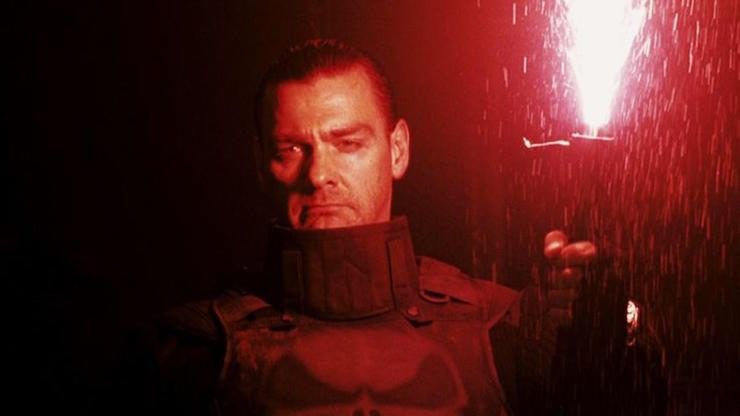
Punisher: War Zone
Written by Art Marcum and Matt Holloway and Nick Santora
Directed by Lexi Alexander
Produced by Gale Anne Hurd
Original release date: December 5, 2008
Mob boss Gaitano Cesare is elderly and dying, but he still runs the Mafia in the New York area. He holds a dinner party at his palatial mansion, which has to be either in Westchester County, out on Long Island, or in New Jersey. I mention this only because there are two NYPD detectives, Soap and Safiotti, watching the house, and no matter where it is, it’s out of their jurisdictions. (There are no mansions like that within the city limits. Trust me.)
Castle attacks the house and kills most of those inside. The only ones he misses are Billy “the Beaut” Russotti and his lieutenants. Safiotti gets the draw on Castle, but all he does is tell Castle where Russotti probably went, and then he punches himself in the face, reporting to Soap that Castle subdued him.
Russotti is in a bottle recycling plant, where Castle attacks him and his people, leaving more dead bodies. Russotti himself falls into a bottle crusher, and somehow survives, but his face is a mess, his prided good looks ruined. He takes on the nickname Jigsaw and swears revenge on Castle.
Castle has other problems, however. One of the mobsters he killed at Cesare’s was an undercover federal agent, Nicky Donatelli. Castle is devastated, and considers hanging up his skull shirt. His armorer, Microchip, tries to talk him out of it in his below-the-subway headquarters, eventually convincing him that he should at least go after Russotti. His attempt to make reparations to the Donatelli family is met with disgust and rejection by Donatelli’s widow, Angela.
Donatelli’s partner, Agent Paul Budiansky, wants to know why the NYPD hasn’t been able to capture Castle. Captain Ross assigns him to the “Punisher Task Force,” which consists of Soap in the basement.
Castle learns from Carlos Cruz, a friend of Microchip’s, that “Jigsaw” has hired three new guys who do a lot of legwork for him. Castle tracks them down, kills two of them, then extracts from the third that Jigsaw plans to go after Angela and Grace Donatelli before killing him, too.
However, Budiansky manages to capture Castle, mostly because the latter pulls his punches when engaging in fisticuffs with a federal agent. At Castle’s urging, Budiansky and Soap send a patrol car to the Donatelli home, but they arrive after Jigsaw and his crazy-ass brother James (a.k.a. Loony-Bin Jim; Jigsaw broke him out of the asylum) have already gotten there, and they kill the two officers. When the two don’t report in, Budiansky has Soap drive him and the handcuffed Castle to the Donatelli house, then Budiansky goes in, leaving Soap with Castle.
Soap, of course, frees Castle and he goes in to remonstrate with the bad guys. Castle shoots one thug in the face who’s left, to Budiansky’s annoyance. Castle takes Angela and Grace to his underground lair for protection while Jigsaw and Jimmy are taken into custody.
Jigsaw has an ace up his sleeve, though—he was providing port security for the Russian mob, who are bringing a biological weapon into the U.S. to sell to terrorists in Queens. They give up the full details, enabling Homeland Security to capture the Russian mobster, Christa Bulat, and impound the weapons. In exchange, Jigsaw and Jimmy get immunity, and also a police file on Castle’s known associates. (By the way, no law-enforcement agency would ever give up a police file to a civilian, not even as part of a plea bargain.)
Armed with this information, Jigsaw kidnaps Microchip. When Castle doesn’t hear from him, he goes to check up on his friend, leaving Cruz to watch the Donatellis. Jimmy breaks into Castle’s hideout and kidnaps Angela and Grace, leaving Cruz for dead.
A livid Castle teams up with Budiansky, who wants to rescue the Donatellis. Jigsaw’s immunity agreement ties his hands legally, but Budiansky instead lets Bulat’s father know where Jigsaw can be found. While Jigsaw’s people are tied up in a shootout with the Russian mob, Castle is able to go in and rescue the Donatellis, and also kill both Jigsaw and Jimmy.
Angela tells Castle that she and her husband used to argue about Castle all the time—Nicky thought that Castle was one of the good guys. One wonders if he still thought that as he died…
“Oh my God—now I have brains splattered all over me.”
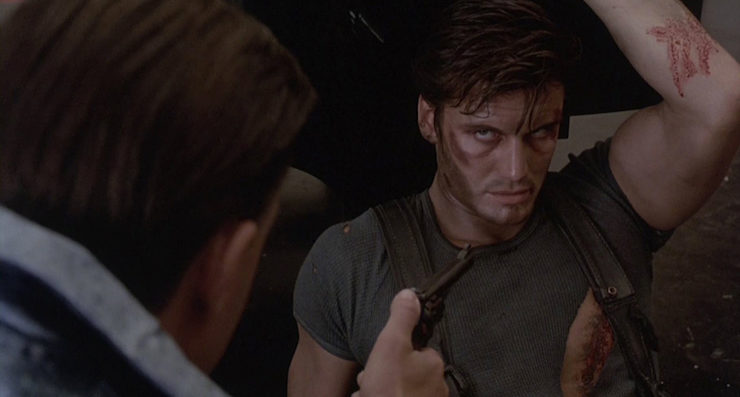
It’s interesting to watch these three takes on the Punisher because—while all three, truly, are the same film—it’s instructive to see how the details differ, and what works and what doesn’t.
Most fundamentally, the movies improve each time in terms of casting the lead. Dolph Lundgren is, in a word, terrible. He grimaces a lot and mutters his lines and stares blankly into space. Thomas Jane actually manages to make Castle a person in the opening parts of the movie, making the blank affect he has as the Punisher much more effective, because we actually see the change. Even so, though, Jane’s character reminds me a lot of the character the Punisher is based on, Mack Bolan, who’s pretty much an automaton, and spectacularly boring. (I do like how Jane delivers the monologue about the meaning of the word “upset” during his brief conversation with his old FBI partner and their boss on the subject of the lack of arrests for the Castle family massacre.)
It’s left to Ray Stevenson to actually bring nuance to the role. Stevenson’s facial expressions are subtle and pained. You can see the agony of his life etched on his face, from the visit to his family’s grave to his realization that he killed a federal agent to his unwillingness to let Budiansky go down the same dark road he’s on.
Lundgren, at least, is in good company, as his movie is chock full of terrible acting, the only exception being Lou Gossett Jr., who actually decided to make Berkowitz a character rather than a caricature or cliché. Nancy Everhard (who we just saw as Christa Klein in The Trial of the Incredible Hulk) doesn’t elevate Leary beyond Person Berkowtiz Talks To, Barry Otto’s Shake is embarrassing, Kim Miyori is a tiresome stereotype as Tanaka, and Jeroen Krabbe can’t even be arsed to manage a tiresome stereotype as Franco. (I’ve never understood why anybody ever hires Krabbe to act, as I’ve seen no evidence that he’s capable of it.)
The villains, sadly, don’t get much better. John Travolta as Saint is better than Krabbe, but that’s a low bar to clear, and mostly Saint comes across as a low-rent version of the villains Travolta played in Face/Off and Broken Arrow. And Dominic West leaves no piece of scenery unchewed as Jigsaw. Much like Jack Nicholson before him, West is far more effective as Russotti the gangster than he is after the transformative experience that turns him into Jigsaw, at which point he devolves into a giggling goon (not helped by a weak-tea psychotic performance by Doug Hutchison as Jimmy).
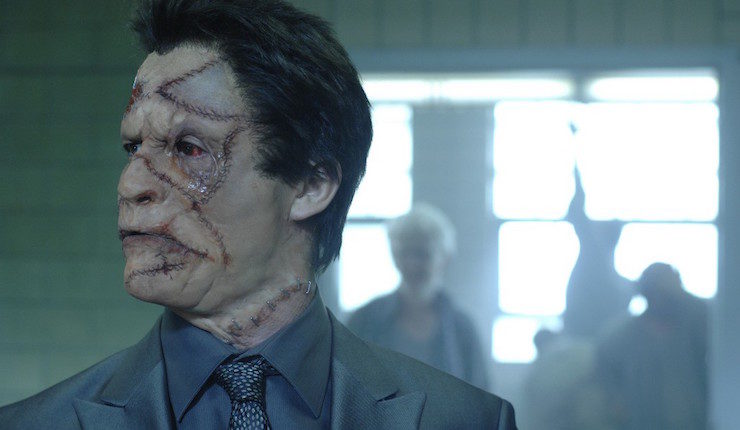
It’s too bad, as West is capable of much better than this (cf. The Wire, 300, John Carter, etc.). But then, so is most of the cast, which is of a higher overall caliber than the other two—Colin Salmon, Wayne Knight, Julie Benz—but none of them turn in their best work here. I do appreciate the effort West and Benz made to put on Noo Yawk accents—they’re even pretty consistent, even if West’s is sometimes a bit labored.
We get three different origins for the Punisher in these three movies, with the first two adding a law-enforcement background to Castle’s military past (in the comics—and also in Netflix—he went straight from the military to his family being killed). Jane’s movie, at least, lets us see Castle with his family and his wife and kid are people with dialogue instead of dewy-eyed memories, which adds to the character’s tragedy, and makes us invest in Castle a bit more.
What I find most fascinating about these three movies is that each one gets closer and closer to the comic book source material, and it’s the one that hews most closely to the comics, War Zone, that is the strongest movie (of, admittedly, a weak bunch). There’s a lesson in that, methinks. In War Zone, Castle’s family is killed in Central Park after witnessing a gangland murder, just like in the comics, and the characters of Microchip and Jigsaw are also from Marvel. To be fair, Jane’s movie also pulls plenty of elements from the comics, in particular Joan, Bumpo, and Dave, who are brilliantly performed by Rebecca Romijn, John Pinette, and Ben Foster.
War Zone is one of only two films that Marvel Studios produced under its Marvel Knights sub-studio—the other being Ghost Rider: Spirit of Vengance. The same year as War Zone, they also put out Iron Man, which turned out to be a better harbinger of things to come from Marvel Studios.
Next week, I’ll be reviewing Netflix’s take on The Punisher with Jon Bernthal, and on this here rewatch we’ll indulge in some early-20th-century nostalgia as we look at the 1990s takes on The Rocketeer and The Phantom.
Keith R.A. DeCandido will be one of the many author guests at Philcon 2017 in Cherry Hill, New Jersey this weekend, along with guests of honor Seanan McGuire (a.k.a. Mira Grant), Bed & Breakfast, Don Maitz, and Janny Wurtz. His schedule can be found here, and he’ll also be putting in time at the eSpec Books table in the dealer room.










